True/False
Indicate whether the
statement is true or false.
|
|
|
1.
|
Common Sense was authored by Thomas Jefferson.
|
|
|
2.
|
American colonists were influenced by the British philosopher John Locke.
|
|
|
3.
|
There was no executive branch under the Articles of Confederation.
|
|
|
4.
|
American government evolved from the colonial governments.
|
|
|
5.
|
The First Continental Congress was held in 1774.
|
|
|
6.
|
Congress under the Articles of Confederation had two houses.
|
|
|
7.
|
The British forbade the colonies from self-government.
|
|
|
8.
|
The state conventionn ratifying method has been used only once—to repeal
Prohibition.
|
|
|
“Congress shall make no law respecting an establishment of religion, or
prohibiting the free exercise thereof; or abridging the freedom of speech, or of the press; or the
right of the people peaceably to assemble, and to petition the Government for a readdress of
grievances.”—First Amendment, 1791
|
|
|
9.
|
According to the First Amendment, citizens have the right to criticize the
government.
|
|
|
10.
|
There are 5 Articles in the Constitution.
|
|
|
11.
|
The Thirteenth Amendment changed the powers of the national and state
governments.
|
|
|
12.
|
The Preamble states that the U.S. Constitution was established—in
part—to provide for the common defense.
|
|
|
|
|
|
13.
|
 The federal government employs more people than
local government.
|
|
|
|
|
|
14.
|
 The cartoon states that Americans prefer
“big” government.
|
|
|
|
|
|
15.
|
 This cartoon depicts gerrymandering in a negative
way.
|
|
|
|
|
|
16.
|
 Veterans’ Affairs is a subcommittee of Ways
and Means.
|
|
|
Swings in Control of Congress
|
|
|
17.
|
 There were 4 independents in the House of
Representatives from 1937 to 1939.
|
|
|
“I have a firm belief we have too many laws on the books now. . . .
I’ve made it pretty clear I believe constituent service is most important and is where a
freshman can be most effective.”
—John J. Duncan,
Jr., 1988
|
|
|
18.
|
 John J. Duncan, Jr. thinks that first-time Congress
members should help shape new legislation.
|
Multiple Choice
Identify the
choice that best completes the statement or answers the question.
|
|
|
19.
|
His ideas deeply influenced the colonists
a. | Thomas Jefferson | c. | King George III | b. | Thomas Paine | d. | John Locke |
|
|
|
20.
|
This proposed a weak executive with more than one person
a. | The New Jersey Plan | b. | The Virginia Plan |
|
|
|
21.
|
This proposed a two-house legislature
a. | The New Jersey Plan | b. | The Virginia Plan |
|
|
|
22.
|
Congress under the Articles of Confederation has this power:
a. | make taxes | c. | regulate trade | b. | amend the Articles of
Confederation | d. | enforce
laws |
|
|
|
23.
|
He made new taxes on the colonies
a. | Thomas Paine | c. | John Locke | b. | King George III | d. | Thomas
Jefferson |
|
|
|
24.
|
Many Americans wanted a strong national government after:
a. | the economic depression | c. | Shays’s
Rebellion | b. | the Annapolis Convention | d. | the Northwest Ordinance |
|
|
|
25.
|
This convinced the Confederation Congress to call a convention to revise the
Articles of Confederation
a. | Shays’s Reellion | c. | the economic depression | b. | the Annapolis
Convention | d. | the Northwest
Ordinance |
|
|
|
26.
|
He is the author of the Declaration of Independence
a. | Thomas Jefferson | c. | King George III | b. | John Locke | d. | Thomas Paine |
|
|
|
27.
|
He is the author of Common Sense
a. | John Locke | c. | King George III | b. | Thomas Paine | d. | Thomas
Jefferson |
|
|
|
|
|
|
28.
|
If the Supreme Court rules a law unconstitutional, under which principle would
the Court be exercising its authority?
a. | Federalism | c. | checks and balances | b. | judicial review | d. | separation of
powers |
|
|
|
29.
|
Which constitutional principle divides power between national and state
governments?
a. | checks and balances | c. | separation of powers | b. | limited government | d. | federalism |
|
|
|
30.
|
Which principle grants the president the authority to appoint federal
judges?
a. | judicial review | c. | checks and balances | b. | Federalism | d. | separation of
powers |
|
|
|
Systems of Checks and
Balances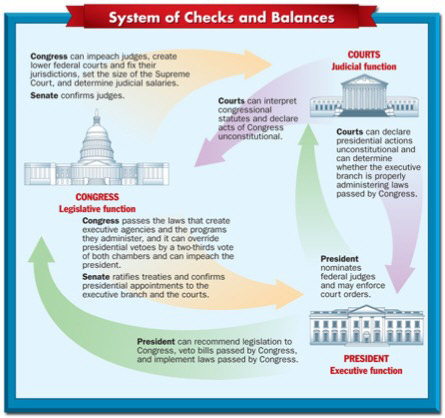
|
|
|
31.
|
To whom does the system of checks and balances give the authority to confirm
judges?
a. | Senate | c. | Congress | b. | President | d. | Courts |
|
|
|
32.
|
Under the system of checks and balances, the Courts have the power to
a. | create lower federal courts. | b. | pass laws creating executive
agencies. | c. | declare presidential actions unconstitutional. | d. | all of the
above. |
|
|
|
33.
|
Article I of the Constitution created the voice of the people in the
a. | House of Representatives. | c. | executive
branch. | b. | Supreme Court. | d. | Senate. |
|
|
|
34.
|
This elevated the Supreme Court to a higher status, balancing the powers of the
other branches.
a. | Constitutional amendment | c. | judicial review | b. | judicial
activism | d. | enumerated
powers |
|
|
|
“He shall, from time to time, give the Congress information of the
State of the Union, and recommend to their consideration such measures as he shall judge necessary
and expedient . . . ”
— Article II, Section
3
|
|
|
35.
|
Article II, Section 3 of the Constitution details whose role in creating
legislation.
a. | vice president’s | c. | president’s | b. | secretary of state’s | d. | Congress’s |
|
|
|
|
|
|
36.
|
Which amendment establishes the separation of church and state?
|
|
|
37.
|
Which amendment establishes the need for a warrant or probable cause before a
person can be searched or arrested?
|
|
|
38.
|
Which amendment ensures that a person will not be tried twice for the same
crime?
|
|
|
Amendment 22
Ratified 1951
Limit on presidential terms | Amendment 25
Ratified 1967
Presidential disability and succession | Amendment 23
Ratified 1961
Presidential
electors for the District of Columbia | Amendment 26
Ratified 1971
Votes for eighteen year
olds | Amendment 24
Ratified
in 1964
Abolition of poll tax | Amendment 27
Ratified 1992
Restraint on
congressional salaries | | |
|
|
|
39.
|
In what year were limitations placed on the term of the presidency?
|
|
|
40.
|
How many years passed between the ratification of amendments Twenty-six and
Twenty-seven?
|
|
|
41.
|
Which amendment addressed the salaries of the members of Congress?
|
|
|
|
|
|
42.
|
The U.S. Constitution is divided into three parts. Choose the answer that best
completes the chart, identifying the three parts.
a. | Sections | c. | Essays | b. | Articles | d. | Bill of Rights |
|
|
|
|
|
|
43.
|
Choose the answer that best defines the type of agreement illustrated in the
graphic organizer.
a. | international agreement | c. | treaty | b. | executive
agreement | d. | foreign
policy |
|
|
|
|
|
|
44.
|
Which amendment repealed Prohibition?
|
|
|
45.
|
Which amendment abolished the poll tax?
|
|
|
46.
|
This section of the Constitution states why it was written.
a. | Amendments | c. | Bill of Rights | b. | Preamble | d. | Articles |
|
|
|
47.
|
To protect liberty and specify its powers, the Framers gave Congress
a. | judicial reviews. | c. | judicial restraint. | b. | executive powers. | d. | expressed
powers. |
|
|
|
48.
|
This action is required to override a presidential veto.
a. | a Constitutional convention | c. | a two-thirds vote of each
house | b. | a Supreme Court ruling | d. | a judicial review |
|
|
|
49.
|
The first 10 amendments are called the
a. | enumerated Articles. | c. | Bill of Rights. | b. | Preamble. | d. | Constitution. |
|
|
|
50.
|
The Founders created a Constitution that could be adapted for the future
through
a. | Constitutional amendment. | c. | judicial
restraint. | b. | Constitutional ratification. | d. | prior
restraint. |
|
|
|
|
|
|
51.
|
Which document granted all of the rights and freedoms listed in the
chart?
a. | Virginia Declaration of Rights | c. | English Bill of
Rights | b. | Bill of Rights | d. | Magna Carta |
|
|
|
52.
|
The Constitution is based on the concept of
a. | jurisdiction. | c. | popular sovereignty. | b. | judicial activism. | d. | expressed
powers. |
|
|
|
53.
|
What body decides if a territory will be admitted to the Union
a. | Judicial | c. | Congress | b. | Executive | d. | State
Department |
|
|
|
|
|
|
54.
|
 Around how many government employees—federal,
state, and local—were there in 1990? a. | 10 million | c. | 4 million | b. | 14 million | d. | 18 million |
|
|
|
55.
|
 According to the chart, government employment ____
from 1960 to 1980. a. | decreased | c. | doubled | b. | stayed the same | d. | tripled |
|
|
|
Federal Revenue Returns to the States,
2002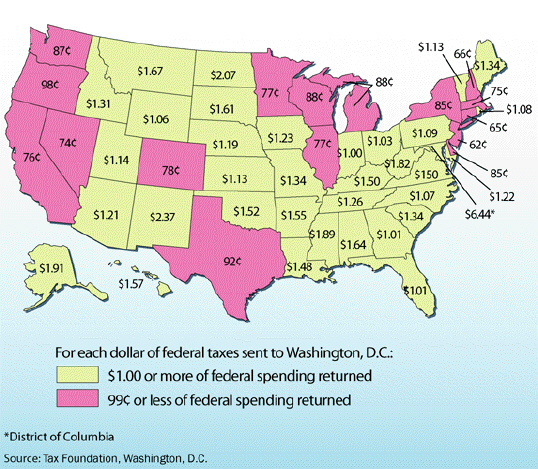 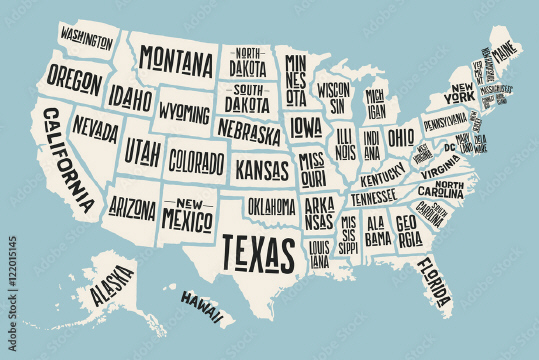
|
|
|
56.
|
 According to the chart, which state receives the
most federal aid? a. | Montana | c. | West Virginia | b. | New Mexico | d. | Alabama |
|
|
|
57.
|
 How many states have less federal spending returned
than they pay in taxes?
|
|
|
58.
|
This affects criminals who flee a state to avoid punishment.
a. | sunshine laws | c. | sunset laws | b. | extradition | d. | civil laws |
|
|
|
59.
|
State and national governments share the power to levy taxes and
a. | declare war. | c. | coin money. | b. | regulate intrastate
commerce. | d. | establish
courts. |
|
|
|
|
|
|
60.
|
 Study the chart. Which state allows voters to
register on Election Day? a. | North Carolina | c. | Texas | b. | Wisconsin | d. | California |
|
|
|
61.
|
 Study the chart. Which state requires voters to
register the farthest in advance? a. | Wisconsin | c. | California | b. | Texas | d. | North Carolina |
|
|
|
62.
|
The Constitution grants these powers to only the national government.
a. | reserved powers | c. | concurrent powers | b. | denied powers | d. | expressed
powers |
|
|
|
|
|
|
63.
|
 Choose the answer that best completes the chart,
providing an example of an implied power. a. | enact/enforce laws | c. | establish courts | b. | conduct draft | d. | establish diplomatic
relations |
|
|
|
64.
|
Article IV of the Constitution obligates states to give this to one
another's citizens.
a. | equal treatment | c. | obedience to the sunset laws | b. | interstate
compacts | d. | full faith for
credit cards |
|
|
|
|
|
|
65.
|
 Identify which of its powers the national government
uses to carry out the actions listed in the graphic organizer: a. | implied | c. | expressed | b. | enumerated | d. | inherent |
|
|
|
66.
|
The national government provides money to the states through this.
a. | mandates | c. | prior restraint | b. | federal grants | d. | preemption |
|
|
|
“The proposed Constitution, so far from implying an abolition of the
State governments, makes them constituent parts of the national sovereignty, by allowing them a
direct representation in the Senate, and leaves in their possession certain exclusive and very
important portions of sovereign power. This fully corresponds . . . with the idea of a federal
government.”—Alexander Hamilton, 1787
|
|
|
67.
|
 What concept was Hamilton defining? a. | socialism | c. | federalism | b. | democracy | d. | nationalism |
|
|
|
68.
|
An agreement between states is called
a. | an interstate compact. | c. | the sunshine law. | b. | a judicial proceeding. | d. | a public act. |
|
|
|
69.
|
Franklin D. Roosevelt and others who favor federal action believe in the
a. | sunshine law. | c. | nationalist position. | b. | sunset
law. | d. | states' rights
position. |
|
|
|
70.
|
Chief Justice Roger B. Taney and others who favor local action believe in
a. | the nationalist position. | c. | the sunrise
law. | b. | the sunset law. | d. | the states' rights position. |
|
|
|
“A person charged in any state with treason, felony, or other crime,
who shall flee from justice, and be found in another State, shall, on demand of the executive
authority of the State from which he fled, be delivered up, to be removed to the State having
jurisdiction of the crime.”—Article IV, Section
2
|
|
|
71.
|
 Under Article IV, Section 2 of the U.S.
Constitution, states are required to do this to criminals and fugitives of other states. a. | charge | c. | extradite or return | b. | provide immunity for | d. | provide representation
for |
|
|
|
Congressional Apportionment,
2000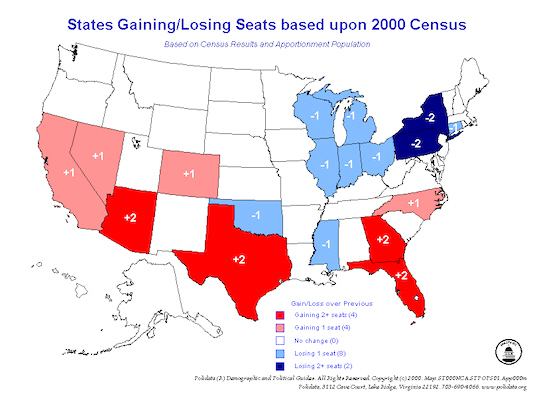
|
|
|
72.
|
 How many states gained seats in the House of
Representatives after the 2000 redistricting?
|
|
|
73.
|
 How many states lost seats in the House of
Representatives after the 2000 redistricting?
|
|
|
74.
|
The presiding officer of the House of Representatives is the
a. | majority whip. | c. | vice president. | b. | Speaker. | d. | majority
leader. |
|
|
|
Committee Structure of
Congress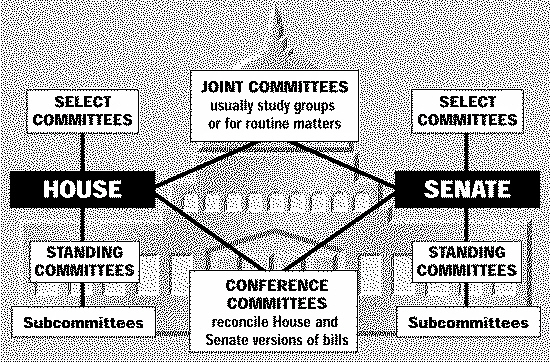
|
|
|
75.
|
 Which committee works out differences between
similar bills in the House and Senate? a. | Joint | c. | Conference | b. | Select | d. | Standing |
|
|
|
|
|
|
76.
|
 Which House committee does not have a counterpart in
the Senate? a. | Ways and Means | c. | Armed Services | b. | Judiciary | d. | Budget |
|
|
|
77.
|
This is NOT a qualification for election to the House of
Representatives.
a. | a degree in law | c. | legal resident of state of election | b. | at least 25 years
old | d. | a citizen for 7
years |
|
|
|
Swings in Control of Congress
|
|
|
78.
|
 During which time period did Democrats have the
greatest hold on the Senate? a. | 2003–2005 | c. | 1937–1939 | b. | 1921–1923 | d. | 1965–1967 |
|
|
|
79.
|
 Study the chart. During what period did Republicans
hold the most seats in the House of Representatives? a. | 1999–2001 | c. | 1921–1923 | b. | 1947–1949 | d. | 1937–1939 |
|
|
|
|
|
|
80.
|
 Choose the answer that best completes the chart,
identifying the houses of the legislature. a. | Senate | c. | Speaker of the House | b. | Congress | d. | Supreme Court |
|
|
|
81.
|
People in districts represented in Congress are called
a. | constituents. | c. | a caucus. | b. | a quorum. | d. | a census. |
|
|
|
|
|
|
82.
|
 The Constitution states three requirements for
Senate eligibility. Choose the answer that best completes the chart. a. | at least 25 years old | c. | at least 18 years old | b. | at least 30 years
old | d. | at least 45 years
old |
|
|
|
|
|
|
83.
|
 The 1st and this district appear to have been
redrawn—note their unnatural shapes—for congressional redistricting.
|
|
|
|
|
|
84.
|
 According to the chart above, about how many people
visited the Library of Congress in 2003? a. | 20 million | c. | 875,197 | b. | around 2.6 billion | d. | over 1 million |
|
|
|
“The Rules Committee is an agent of the leadership. It is what
distinguishes us from the Senate, where the rules deliberately favor those who would delay. The rules
of the House . . . permit a majority to work its will on legislation rather than allow it to be
bottled up and stymied.”—Speaker Jim Wright,
1987
|
|
|
85.
|
 According to Speaker Jim Wright, which governmental
body takes too long to make decisions or take action? a. | Senate | c. | Supreme Court | b. | Rules Committee | d. | Attorney General’s
Office |
|
|
|
|
|
|
86.
|
 Which legislative chamber holds office for
life? a. | Chamber of Duties | c. | House of Lords | b. | State Duma | d. | Senate |
|
|
|
87.
|
 Which two national legislatures have the same number
of members? a. | United States and Egypt | c. | Mexico and
Japan | b. | United Kingdom and Russia | d. | Mexico and Russia |
|
|
|
88.
|
The process of setting up new congressional districts after reapportionment is
called
a. | gerrymandering. | c. | redistricting. | b. | censuring. | d. | bicameral
legislature. |
|
|
|
89.
|
In Congress the majority and minority leaders are assisted by
a. | whips. | c. | the vice president. | b. | the president. | d. | the Speaker. |
|
|
|
90.
|
These committees act as study groups for the combined House and Senate.
a. | standing committees | c. | conference committees | b. | joint
committees | d. | select
committees |
|
|
|
91.
|
The president of the Senate is the
a. | vice president. | c. | majority leader. | b. | Speaker. | d. | minority
leader. |
|
|
|
92.
|
This is NOT a qualification for election to the Senate.
a. | married for 5 years | c. | a citizen for 9 years | b. | at least 30 years
old | d. | legal resident of state
of election |
|
|
|
93.
|
This could bring about a vote of censure.
a. | heroism | c. | sleeping during session | b. | accepting a
bribe | d. | missing a committee
meeting |
|
|
|
94.
|
This is NOT a feature of all the states in today's world.
a. | democracy | c. | territory | b. | government | d. | population |
|
|
|
95.
|
A plan that provides the rules for government is called a
a. | consensus. | c. | preamble. | b. | political party. | d. | constitution. |
|
|
|
96.
|
Any system of government in which rule is by the people is called
a. | an autocracy. | c. | an oligarchy. | b. | a democracy. | d. | a monarchy. |
|
|
|
97.
|
The form of democracy we have in this country is called
a. | indirect democracy. | c. | direct democracy. | b. | representative democracy. | d. | socialistic
democracy. |
|
|
|
|
|
|
98.
|
Choose the best answer that identifies the groups of individuals who organize to
achieve these goals.
a. | framers | c. | political parties | b. | Republicans | d. | electoral
college |
|
|
|
|
|
|
99.
|
Study the chart. Which countries have the same government structure as the
United States?
a. | China, Cuba | c. | Turkey, China | b. | South Africa, India | d. | China, Japan |
|
|
|
100.
|
According to the chart, which of the following countries give its citizens the
least representation and power?
a. | United States | c. | China | b. | South Africa | d. | Turkey |
|
|
|
|
|
|
101.
|
Which document serves the purposes listed in the diagram?
a. | Bill of Rights | c. | Constitution | b. | Preamble | d. | Twenty-First
Amendment |
|
|
|
102.
|
Private ownership and control of resources is characteristic of
a. | mixed-market economy. | c. | communism. | b. | capitalism. | d. | socialism. |
|
|
|
|
|
|
103.
|
Which purpose of government is fulfilled by this sign?
a. | provide for and control the economic system | b. | provide national
security | c. | provide for a common defense | d. | provide public
services |
|
|
|
104.
|
The effort to control or influence the conduct of government is called
a. | laissez-faire. | c. | constitutional law. | b. | free market. | d. | politics. |
|
|
|
105.
|
Any system of government in which a small group holds power is called
a. | a monarchy. | c. | a democracy. | b. | an autocracy. | d. | an oligarchy. |
|
|
|
106.
|
This system divides the power between the state and national governments.
a. | communist | c. | federal | b. | socialist | d. | unitary |
|
|
|
107.
|
The four essential features of a state, or nation, include government,
population, territory, and
a. | command economy. | c. | confederacy. | b. | sovereignty. | d. | democracy. |
|
|
|
108.
|
The Republicans and Democrats have developed in this country as the major
a. | political parties. | c. | proletariat. | b. | types of government. | d. | capitalists. |
|
|
|
|
|
|
109.
|
Choose the answer that best completes the chart.
a. | representative democracy | c. | constitutional
monarchy | b. | republic | d. | oligarchy |
|
|
|
|
|
|
110.
|
Complete the graphic organizer, identifying the form of government that is ruled
by few.
a. | monarchy | c. | oligarchy | b. | totalitarian dictatorship | d. | direct
democracy |
|
|
|
United States
Acquisitions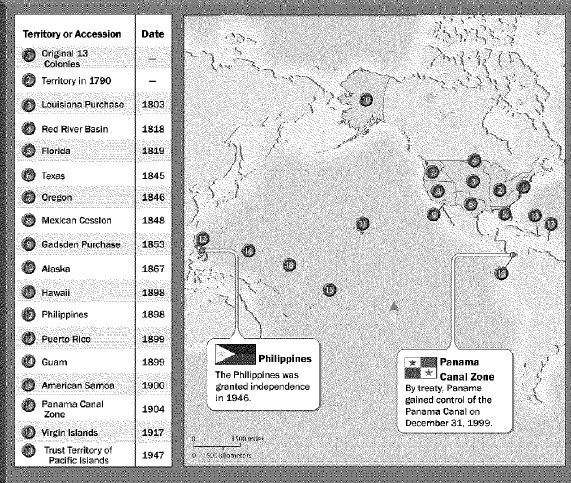
|
|
|
111.
|
This territory, acquired in 1947, was the last acquisition of the United
States.
a. | Trust Territory of Pacific Islands | c. | Red River Basin | b. | Virgin
Islands | d. | Louisiana
Purchase |
|
|
|
112.
|
This territory, acquired by the United States in 1898, was granted its
independence in 1946.
a. | Philippines | c. | Puerto Rico | b. | Guam | d. | Virgin Islands |
|
|
|
|
|
|
113.
|
Complete the graphic organizer defining the purposes of government.
a. | create national library | c. | maintain social
order | b. | provide for economical goods | d. | maintain international
peace |
|
|
|
114.
|
This system of government gives all key powers to the national
government.
a. | federal | c. | unitary | b. | confederacy | d. | anarchy |
|
|
|
115.
|
The economic system in which freedom of choice is emphasized is
a. | command economy. | c. | capitalism. | b. | socialism. | d. | communism. |
|
|
|
116.
|
These nations are in the early stages of industry and technology.
a. | developing nations | c. | unitary systems | b. | developed nations | d. | federal systems |
|
|
|
117.
|
Communist countries have a
a. | free enterprise economy. | c. | laissez-faire
economy. | b. | command economy. | d. | capitalist economy. |
|
|
|
“We, the people of the United States, in Order to form a more perfect
Union, establish Justice, insure domestic Tranquility, provide for the common defence
[defense], promote the general Welfare, and secure the Blessings of Liberty to ourselves
and our Posterity, do ordain and establish this Constitution for the United States of
America.”
|
|
|
118.
|
The goals and purposes of the government are expressed in the passage, which is
known as the
a. | Preamble to the Constitution. | c. | Miranda
warning. | b. | Two Treatises of Government. | d. | Bill of Rights. |
|
Matching
|
|
|
a. | Limited Government | d. | Interstate commerce | b. | Representative Government | e. | Anarchy | c. | Separation of
powers |
|
|
|
119.
|
Trade among the states
|
|
|
120.
|
The concept that the government’s power in not absolute
|
|
|
121.
|
A government in which people elect delegates
|
|
|
122.
|
The power of government is divided
|
|
|
123.
|
Disorder
|
|
|
a. | Expressed powers | g. | Concurrent powers | b. | Implied powers | h. | Interstate compacts | c. | Inherent
powers | i. | Extradition | d. | Elastic clause | j. | States’ rights
position | e. | Reserved powers | k. | Nationalist position | f. | Supremacy clause | l. | Bureaucracy |
|
|
|
124.
|
The legal process in which one state surrenders an accused criminal to another
state
|
|
|
125.
|
Powers that belong strictly to the states
|
|
|
126.
|
Powers the national government requires to carry out the expressed
powers
|
|
|
127.
|
The belief that the national government’s powers should be narrowly
defined
|
|
|
128.
|
Powers the state and national governments exercise independently
|
|
|
129.
|
Powers governments exercise simply because they are governments
|
|
|
130.
|
Government agencies with specialized knowledge to implement a program
|
|
|
131.
|
Agreements made between two states
|
|
|
132.
|
Powers given to the national government in the Constitution
|
|
|
133.
|
States that Congress can make all laws that are necessary and proper
|
|
|
134.
|
The belief that the national government’s powers should be
expanded
|
|
|
135.
|
States that US acts and treaties are superior to those of the states
|
|
|
a. | Sovereignty | h. | Oligarchy | b. | State | i. | Democracy | c. | Unitary
System | j. | Political
Parties | d. | Federal System | k. | Capitalism | e. | Constitution | l. | Socialism | f. | Politics | m. | Communism | g. | Autocracy |
|
|
|
136.
|
the people hold the power of government
|
|
|
137.
|
a small group holds power in government
|
|
|
138.
|
government owns the means of production, plans the use of resources, and
provides basic social services
|
|
|
139.
|
this evolved from the family group
|
|
|
140.
|
gives all key powers to the national or central government
|
|
|
141.
|
power or authority reside in a single individual
|
|
|
142.
|
based on individual economic choices
|
|
|
143.
|
based on the idea that capitalism exploited workers
|
|
|
144.
|
divides the powers of government between the national and state
governments
|
|
|
145.
|
absolute authority within territorial boundaries
|
|
|
146.
|
plan that provides the rules for government
|
|
|
147.
|
effort to control or influence the policies and actions of government
|
|
|
148.
|
choose candidates for office, respect the voters’ decisions, and act as
loyal opposition
|
Short Answer
|
|
|
149.
|
Explain why laws differ from state to state and how those differences are
related to federalism.
|
|
|
150.
|
Explain why the House might be considered more representative of the people than
the Senate.
|
|
|
151.
|
Compare who benefits from government decisions made in an autocracy with who
benefits from government decisions made in a representative democracy.
|
|
|
152.
|
Name one power that the Constitution denies to the states, and explain how the
nation benefits from that restriction.
|
Essay
|
|
|
153.
|
Explain why some Americans would’ve wanted a weak central government after
the Revolution.
|
|
|
“A well-regulated Militia being necessary to the security of a free
State, the right of the people to keep and bear Arms shall not be infringed.”—Second Amendment, 1791
|
|
|
154.
|
The Second Amendment grants citizens the “right to bear arms.” Some
believe this right was only meant to extend to militia—armed forces of citizens responsible for
the state’s security. Do you agree or disagree? Why?
|